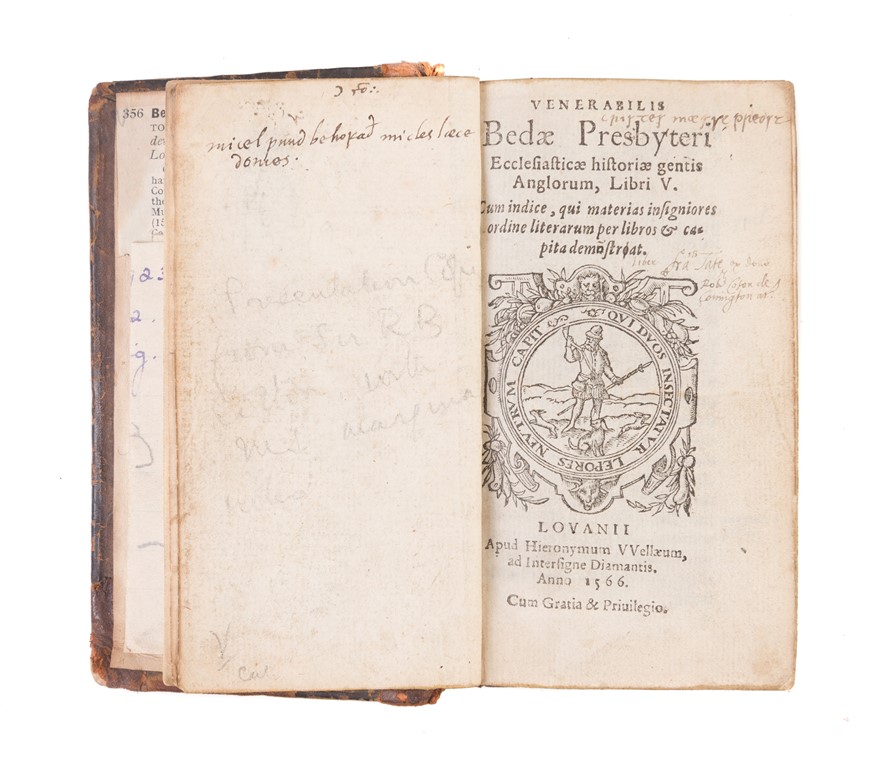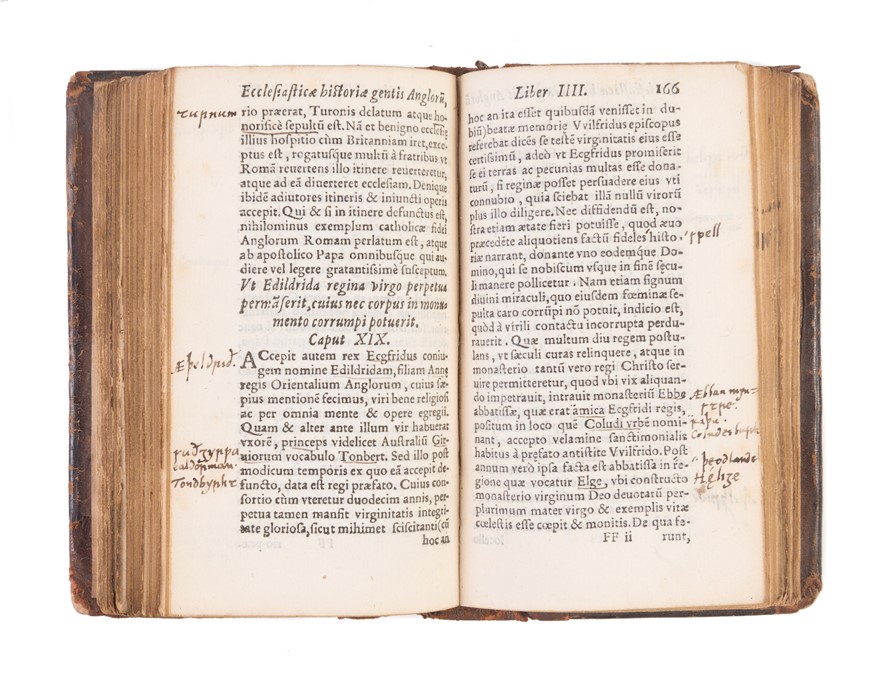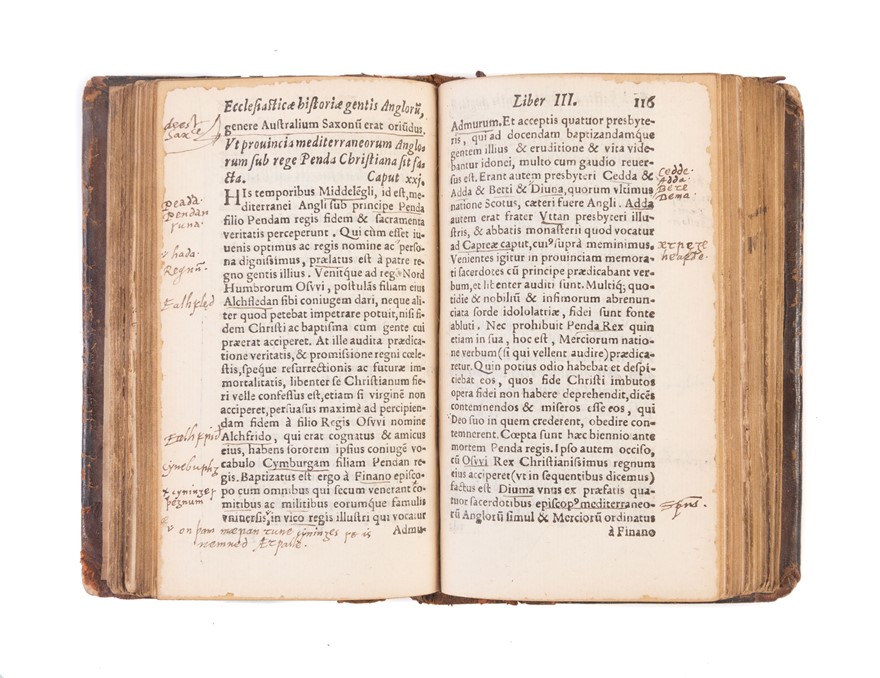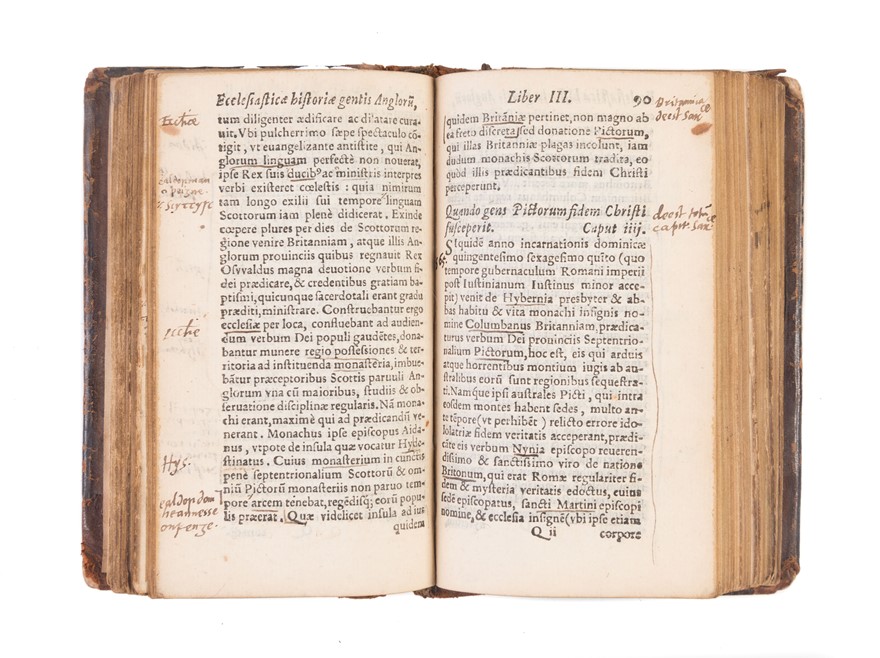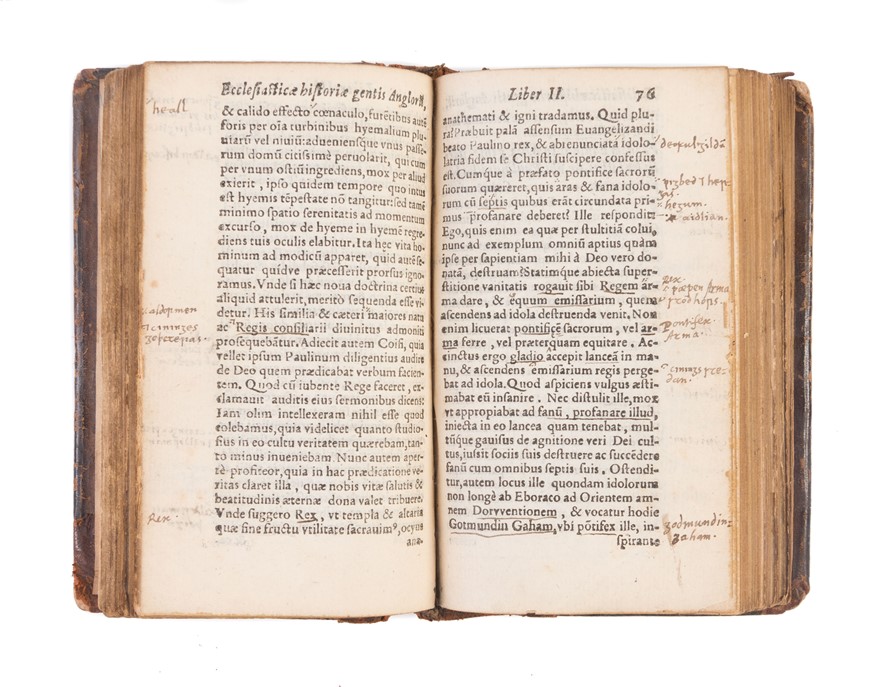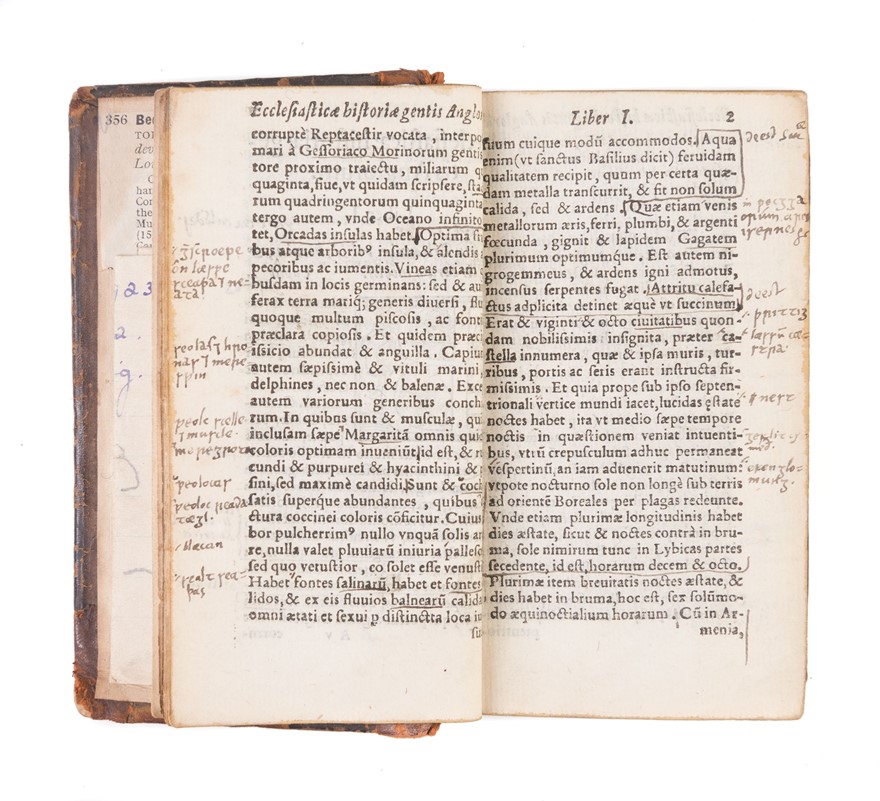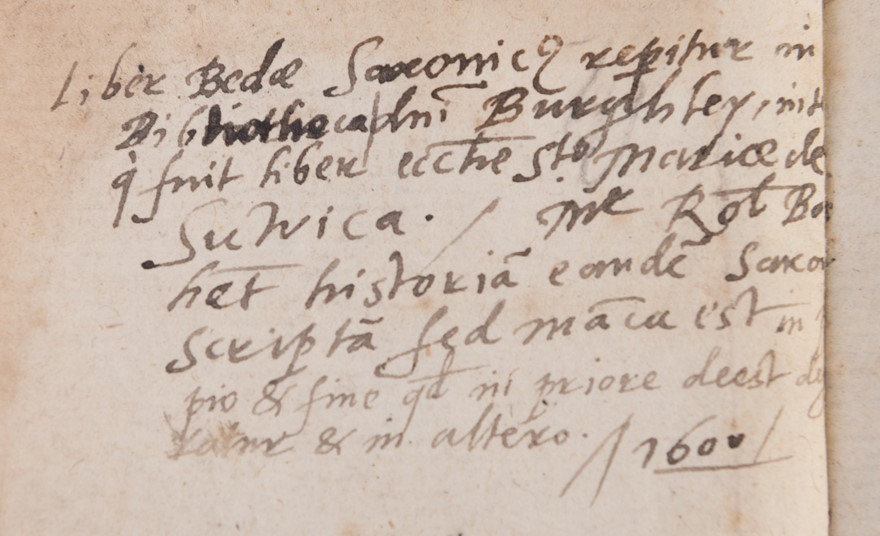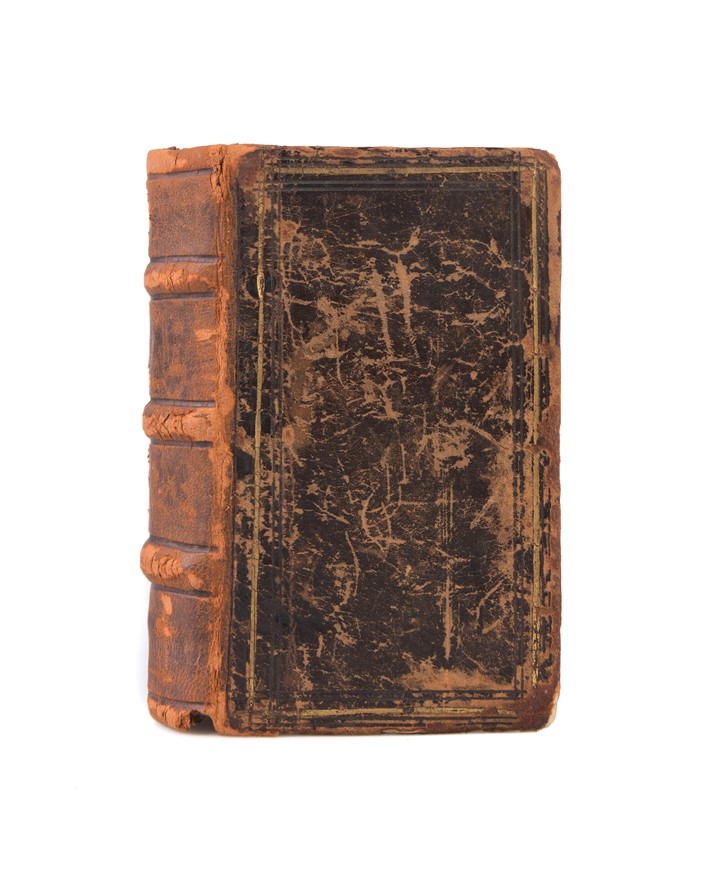Ecclesiasticae historiae gentis Anglorum, Libri V.
BEDE , The Venerable, 673/4-735 (1566)
£55000.00
Please contact us in advance if you would like to view this book at our Curzon Street shop.
CAREFULLY COLLATED WITH THE OLD ENGLISH TRANSLATION AND ANNOTATED THROUGHOUT BY THE SCHOLAR FRANCIS TATE
Cum indice, qui materias insigniories ordine literarum per libros & capita demo[n]strat [the last word corrected by hand from ['demnstroat'].
12mo. [Text: 119 x 70 mm]. [4], 248, [10] leaves. Small woodcut printer's device of a huntsman on the title and a larger oval version on the final page. Contemporary calf, covers ruled in gilt and blind (covers scratched, corners worn, old plain reback in cheap sheep, now very rubbed and worn, headbands broken, endleaves replaced, c. 1900).
Louvain: Hieronymus Wellaeus,
Bede's Historia Ecclesiastica was first published at Strassburg, "not after 1475"; this edition reprints the revised Antwerp 1550 edition and is the seventh separate edition.
CAREFULLY COLLATED WITH THE OLD ENGLISH TRANSLATION AND ANNOTATED THROUGHOUT BY THE SCHOLAR FRANCIS TATE USING A (NOW LOST) MANUSCRIPT FROM ROBERT BOWYER'S LIBRARY AND ANOTHER MANUSCRIPT (NOW IN THE BRITISH LIBRARY) FROM ROBERT COTTON'S.
Inscriptions (1:) Inscribed on the first front flyleaf: 'Liber Bedæ Saxonicus reperitur in | Bibliotheca domini Burghley, insc[ri ... ?] | qui fuit liber ecclesie Ste Mariæ de | Suwica./ Mr Robertus Bo[wyer ?] | habet historiam eandem Saxo[nic... ?] | scriptam sed ma[ter?]ia est in p[rinci-]| pio & fine quod in priore deest de[side-] | ratur & in altero. / 1600 /'. (2:) Inscribed on the second front flyleaf (opposite the title) in Old English: 'micel wund behofað micles laecedomes' ['A great wound requires great medicine' - Bede]. (3:) Inscribed at the head of the title-page in Old English (rather in the manner of the legal historian William Lambarde): 'cristes maerye preost' ['Christ, Mary, Priest']. (4:) Inscribed neatly on title page: 'Liber Fra[nci]is Tate ex dono | Rob[ertus] Coton de | Conington ar[miger].' (5:) The three rear flyleaves contain three pages of references to Tacitus's Annales and Life of Agricola and some index references, mostly to emperors and kings, in ink.
The first inscription is an archetypal scholarly note, about two manuscript copies of Bede’s work which is printed in this book. The first of these manuscripts is stated to be in the library of Lord Burghley (i.e., Sir William Cecil (d. 1598), Queen Elizabeth’s Principal Secretary and then Lord Treasurer), and it is then stated that this was once in the library of St Mary’s ‘Suwica’, that is, Southwick priory in Hampshire. This copy is now BL Cotton MS Otho B. xi, fols 1-38, in the British Library. The late Neil R. Ker in his Catalogue of Manuscripts containing Anglo-Saxon (no. 180), dated it to between the mid-10th century and the first half of the 11th, and noted that it had belonged to Cecil in 1562 when it was copied by Lawrence Nowell (BL MS Add. 43703) and to Cotton by 1621. It was badly damaged in the fire at Ashburnham House in 1731.
Mr Robert ‘Bo[-]’ is then stated to have a second copy. This owner, it can be suggested, was Robert Bowyer (d. 1621), of the Middle Temple, Keeper of the Records in the Tower of London (the principal repository of the Crown’s records) from 1604, MP, and then from 1610 Clerk of the Parliaments. The identification is confirmed by Tate’s note beside the chapter heading for Book III, Ch. xix: ‘memorandum quod in libro Saxonico magistri Boyeri. 2. capita seque[n]tia non rep[er]iu[n]tur’. Bowyer was a highly successful collector of medieval manuscripts, securing such incomparable treasures as the Lindisfarne Gospels (BL Cotton MS Nero D. iv) as well as the Anglo-Saxon Chronicle which is now BL Cotton MS Tiberius B. i, fols 115-164 (acquired from Bowyer by Cotton with three other MSS, by exchange) and a mid-11th century psalter glossed in Old English (BL Cotton MS Vitellius E. xviii), while he or his father, William Bowyer, probably owned the collection of Old English homilies which is now Bodleian Library, MS Bodley 342. Francis Tate certainly knew Robert Bowyer well, as Bowyer was a member of the Elizabethan society of antiquaries for which Tate seems to have acted as secretary.
What is remarkable, however, is that Bowyer’s copy of the Old English Bede is now lost. Tate’s mention of it here is our only evidence for its existence. Neil Ker in his Catalogue of Manuscripts containing Anglo-Saxon described each of the six extant manuscripts of the Old English Bede, giving details of their post-medieval history as well, and it is clear that Bowyer’s can be none of these. Two belonged to Archbishop Matthew Parker (d. 1575) and were given by him to institutions. The one from Southwick is mentioned above; one from Thorney abbey will surely have been in East Anglia until it was acquired by Thomas Tanner, who bequeathed it to the Bodleian Library (MS Tanner 10); a fifth belonged in all probability to Brian Twyne (1581-1644) before passing to Corpus Christi College, Oxford (becoming its MS 279, part II), and the sixth, BL, Cotton MS Domitian ix, is only a single leaf (fol. 11).
The fourth inscription, on the title-page, is the key to this volume's importance. It is by the antiquary, judge, Member of Parliament, and legal scholar Francis Tate (1560-1616) recording it as a gift from Robert Cotton (1571-1631) of Conington, Huntingdonshire (later Sir Robert Bruce Cotton, 1st Baronet), the great collector of Medieval and Early Modern manuscripts.
Besides these inscriptions, where the Latin text corresponds with the Old English translation it has been annotated in ink throughout by Tate with careful textual notes and many words and phrases and proper names and place names are given their Old English equivalents in the margins.
Francis Tate (1560-1616), scholar of legal history, was 'a great Lawyer as well as Antiquary, vir multijugæ eruditionis et vetustatis peritissimus [a man most skilled in wide-ranging learning and antiquity], saith Mr. Selden in his Preface to Hengham, and of exquisite skill in the Saxon Language.' - Thomas Hearne, A Collection of Curious Discourses (Oxford, 1720), p. cxx-i).
Collating Bede's Historia Ecclesiastica with the Old English translation and the printed book with which we are particularly concerned, the Latin text of Bede’s Historia Ecclesiastica, crucial to scholars on both sides of the Reformation divide as the fundamental text for the study of the early history of both the Church in England and the Church of England, has been carefully and thoroughly worked over by Tate with a view to ascertaining how its text compares with those of one or more manuscripts of the Old English translation - presumably either that which is now part of the damaged BL Cotton Otho B. xi, or the now-lost version that belonged to Robert Bowyer. Either way, Tate’s readings will be likely to have particular value.
A much longer and detailed description is available on request.
Stock Code: 233617
